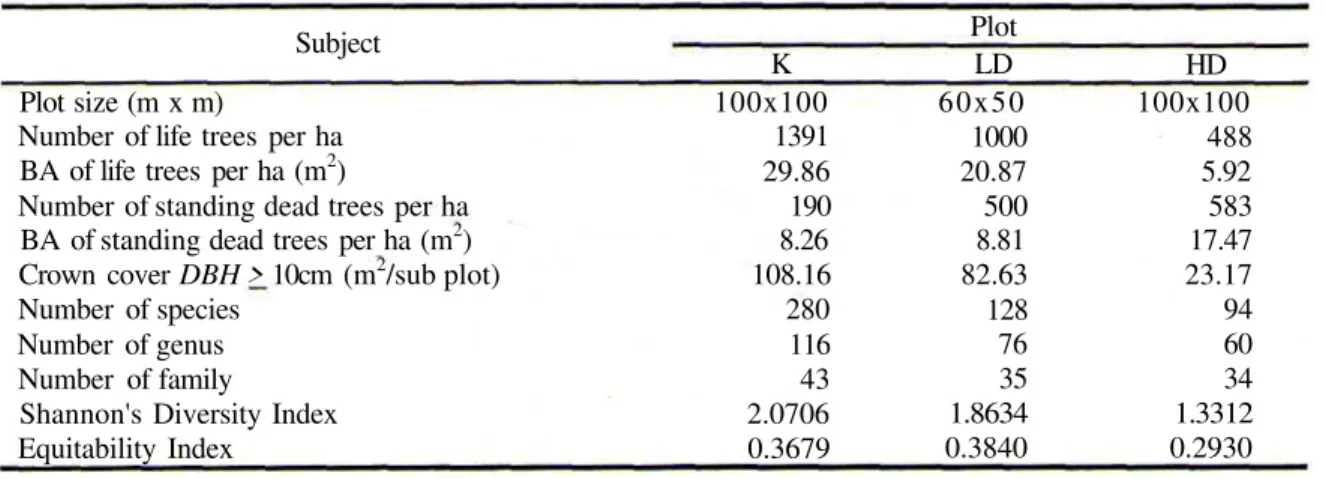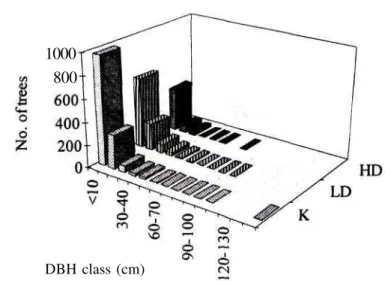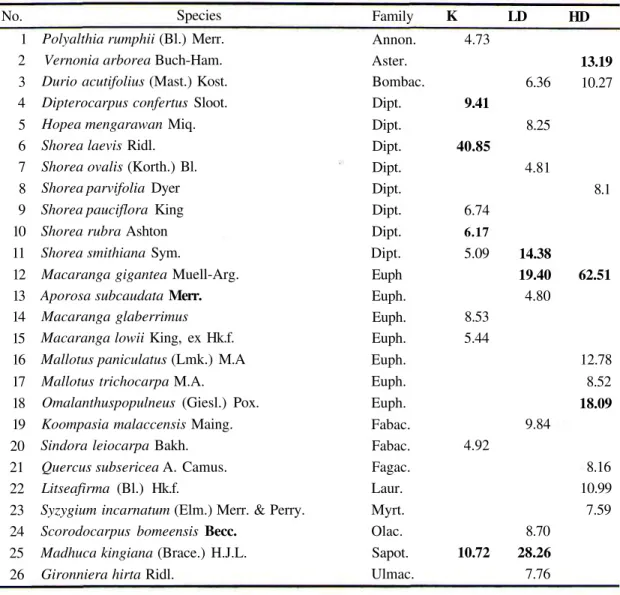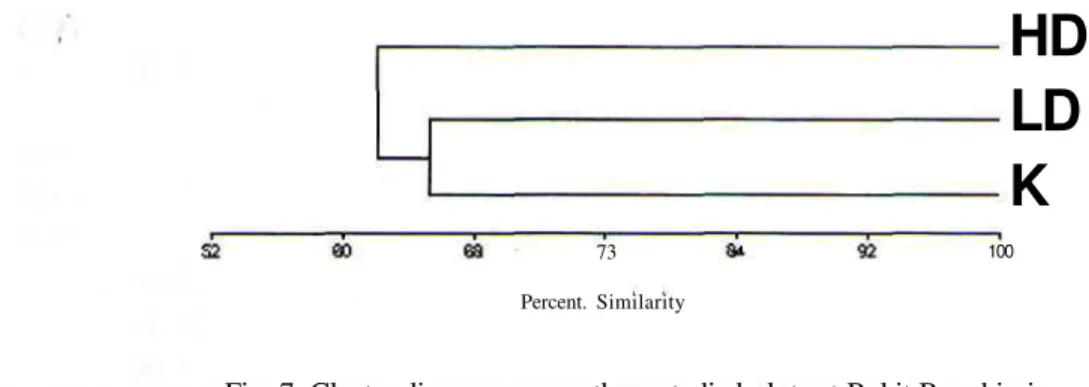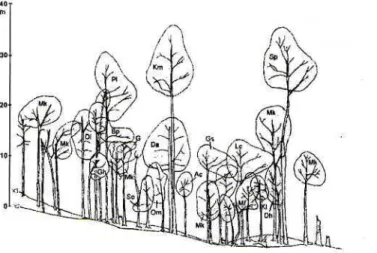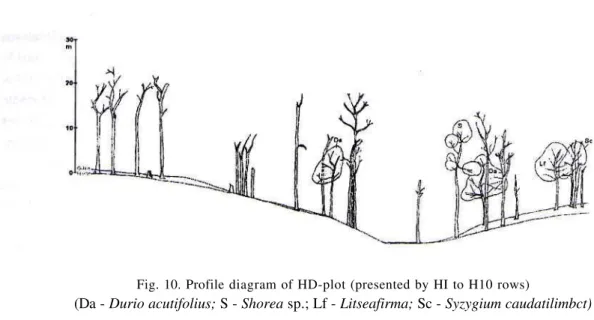IMPACTS OF DRY SEASON AND FOREST FIRE 1997-1998 EPISODES ON MIXED
DIPTEROCARP FOREST AT BUKIT BANGKIRAI, EAST KALIMANTAN
[Pengaruh Musim Kering dan Kebakaran Hutan Episode 1997-1998 Terhadap Hutan
Dipterocarp Campuran di Bukit Bangkirai, Kalimantan Timur]
El
Herwint Simbolon" , Mustaid Siregar", Seiji Wakiyama21, Naozumi Sukigara21, Yasuhisa Abe3) and Hideyuki Shimizu4'
^Herbarium Bogoriense, Botanical Division, RDC for Biology-LIPI, Bogor-Indonesia
2)
Japan Wildlife Research Center, Tokyo-Japan
3)
Forestry and Forest Products Research Institute, Kukizaki-Japan
4)
National Institute of Environmental Studies, Tsukuba-Japan
ABSTRAK
Kawasan Kalimantan Timur mengalami musim kemarau panjang yang merangsang terjadinya kebakaran hutan yang luas pada 1982-1983 dan 1997-1998. Naskah ini mengemukakan hasil penelitian di Bukit Bangkirai, Kalimantan Tengah mengenai dampak dari kemarau panjang dan kebakaran hutan 1997-1998 terhadap diversitas tumbuhan pohon hutan dipterokarp campuran. Penelitian dilakukan dengan cara memperbandinkan hasil pencacahan tumbuhan pohon berlingkar batang setinggi dada lebih daripada 15cm yang terdapat dalam tiga petak penelitian, masing-masing: lha di hutan alam yang tidak terbakar (K-plot), 0,3 ha di hutan yang terbakar ringan (LD) dan lha di hutan yang terbakar berat (HD). Hasil penelitian menunjukkan bahwa musim kemarau panjang 1997-1998 menyebabkan 12,02% mortalitas individual pohon di hutan alam yang tidak terbakar, yang terlihat dari pohon mati berdiri tegak akibat kekeringan, atau kehilangan 21,67% dari total basal area. Secara keseluruhan terlihat bahwa kebakaran hutan menyebabkan kerusakan berat terhadap struktur dan komposisi hutan. Secara kumulatif, kemarau panjang dan kebakaran hutan menyebabkan mortalitas individual pohon berkisar 36-70% dan kehilangan total basal area antara 45-85% dan menyebabkan lantai hutan terbuka terhadap penyinaran matahari langsung karena menurunnya penutupan tajuk sebesar 23-79%. Kebakaran hutan juga berdampak terhadap penurunan biodiversitas tumbuhan pohon sebesar 23-79% pada tingkat jenis, 53-66% pada tingkat marga dan 18-21% pada tingkat suku. Tercatat perubahan komposisi jenis pada hutan yang terbakar; dominasi jenis Dipterocarpaceae dipetak hutan tak terbakar (K) menjadi dominasi pionir sekunder Macaranga gigantea-Vernonia arborea di petak terbakar berat (HD) dan dominasi Macaranga gigantea-Shorea smilhiana di petak terbakar ringan (LD). Beberapa jenis seperti Durio acutifolius dan Syzygium incarnaium mungkin dapat digolongkan sebagai jenis yang relative lebih tahan terhadap api.
Kata kunci/key words: Musim kemarau/dry season, kebakaran hutan/ forest fire, struktur dan komposisi/structure and composition, hutan dipterokarp campuran/mixed dipterocarp forest, Kalimantan Timur/East Kalimantan.
INTRODUCTION
In 1982-1983,1986-1987,1991,1994 and 1997-1998 many areas of Indonesia had experienced very intense dry season that causes severe drought, and devastating wildfires (Lennertz and Panzer, 1984; Simbolon, 2000). It had been noted that wildfire greatly affect the conservation of biodiversity; directly, by burnt down the wildlife; indirectly, by changes the habitat condition, changes local microclimate, and by destroying food or nutrient sources (see also Wirawan, 1993). It was also noted that the wildfires not only affect the biodiversity beyond the burnt areas, but also in the stream by means increasing sedimentation rate due to increase of soil erosion rates in the upper stream; and affect the physiological activities of wildlife due to reduction of solar
radiation. Although those wildfire effects have been noted since 1982, how much was biodiversity damaged, which species was affected directly and indirectly, and to what extend the remaining biodiversity were affected and how they could recover were still not much studied.
East Kalimantan areas were one by the most severely affected of the dry season and forest fire 1997-1998 episode. The dry season was started from the early 1997 and extends to early 1998. The forest fires in Bukit Bangkirai areas were occurred in January 1998 (personal comm. and see also Ghozali and Toma2000). The present paper intends to study the impacts of long dry season and forest fires of 1997-1998 on the biodiversity, including structure and composition of a mixed dipterocarp forest (MDF) in Bukit Bangkirai, East Kalimantan, Indonesia.
Simbolon et al - Impact of Dry Season and Forest Fire on Mixed Dipterocarp Forest
STUDY SITE
The study was conducted at Bukit Bangkirai areas, East Kalimantan and its surroundings. Bukit Bangkirai is located in the northwest, about 58 km away from Balikpapan City, East Kalimantan. Bukit Bangkirai area is a nature recreation park with about 110 m altitude. The area is a part of Mt. Mentawir and Mt. Batuampar ranges. The area is called as Bukit Bangkirai since the hill was dominated by bangkirai trees (a vernacular name for Shorea laevis, Dipterocarp^sae). The area is belonging to PT
INHUTANI-1. Most of the areas have been burnt out during the extensive forest fires following intense long dry season periods of 1982-83 and 1997-98. However, some area around a hill dominated by Shorea laevis was escaped from both extensive forest fires. The unburned areas were then conserved and managed into a natural recreation park, while some of the burnt areas were left to recover naturally, and the other were planted with local and introducing species. At present, in the unburned areas a canopy bridge was also built up.
Fig. 1. (Left): Contour line and gap distribution in K-plot (white are gaps and green are the projection of canopy coverage of trees with DBH of more than 10cm)
Fig. 2. (Right): Contour line and gap distribution in LD-plot (white are gaps and green are the projection of canopy coverage of trees with DBH of more than 10cm)
Fig. 3. Contour line and gap distribution in HD-plot (white are gaps and green are the projection of canopy - coverage of trees with DBH of more than 10cm)
METHODS
After a reconnaissance study to explore the general condition of burned and unburned forest around Bukit Bangkirai areas, then the condition of the forests in the areas were determined subjectively into undisturbed, heavily and lightly damaged forests due to forest fires of 1997-1998. In each of the three types of forest, permanent plots were established. Those established plots are included a 1-ha (100m x 100m) plot in each of natural forest (named /f-plot) and heavily damaged forest (HD-plot), and a 0.3-ha plot (50m x 60m) in a lightly damaged forest (ZjD-plot).
Those K- and HD- permanent plots were then divided into 100 sub plots, whereas the LD-plots divided into 30 sub plots of 10 x 10 m2. All trees with stem girth at breast height (gbh, or at 130 cm above the ground) more than 15 cm (or about 4.8cm in diameter at breast height, DBH) were individually numbered with aluminum tag, mapped the position in the plot, identified to species, and measured gbh, tree height, and two horizontal diameters of crown at right angles includ ing the maximum. The canopy of trees with DBH of more than 10 cm were projected and drawn in a millimeter block. The profile diagrams of forest representing structure of the permanent plots were also drawn.
Based on these measurements, total basal areas, number of species, number of individuals, total crown area, importance value of each species and diversity index in each plot were determined. The
importance value of each species was calculated based on the Greigh-Smith (1964), while diversity index was calculated based on the Shannon's Index of diversity. Percent of similarities among those plots where then clustered by using "Nearest Neighbor methods".
RESULT Established plots
Those three permanent plots were established in each forest type with parallel direction, where axis X (in numerical order: 1 to 5 or 10) laid down from west to east and abscise Y (in alphabetical order: A to F or J) from south to north. Topographical condition of established plots are illustrated in the Figs. 1,2 and 3. The differences of the ground height between the highest and lowest site in the plots were 33, 16.3 and 19.7 m in K-, LD- and HD- plots, respectively.
Forest structure
The summary of gathered information on the forest structure from each of established plots are presented in the Table 1. Tree density, total basal areas, and tree canopy coverage were higher in K-(un-burnt) than in LD- than in HD- plots, while number of standing dead trees and total basal areas are lower. The trunk diameter class distribution of life trees and standing dead trees in those tree study sites depicted an inverse ./-shaped curve (Figs. 4 and 5). Number of life trees with DBH > 10cm at K- are little higher than of at LD- and much higher than of
HD-Table 1. Some gathered information on the forest structure from each plot Subject
Plot size (m x m)
Number of life trees per ha BA of life trees per ha (m2)
Number of standing dead trees per ha BA of standing dead trees per ha (m2) Crown cover DBH > 10cm (m2/sub plot) Number of species
Number of genus Number of family
Shannon's Diversity Index Equitability Index K 100x100 1391 29.86 190 8.26 108.16 280 116 43 2.0706 0.3679 Plot LD 6 0 x 5 0 1000 20.87 500 8.81 82.63 128 76 35 1.8634 0.3840 HD 100x100 488 5.92 583 17.47 23.17 94 60 34 1.3312 0.2930
Simbolon et al - Impact of Dry Season and Forest Fire on Mixed Dipterocarp Forest
1000 800
DBH class (cm)
Fig. 4. Trunk diameter class distribution of life trees in the study plots.
£
DBH class (cm)
Fig. 5. Trunk diameter class distribution of standing dead trees in the study plots.
0 20 40 60 80 100 Plot unit (100 m2)
plots, with 426; 373 and 99 individual trees per ha, respectively. The similar pattern was also found on the number of life tree with less than 10cm in DBH, with 965; 627 and 3 89 trees per ha in K-, LD- and HD-plots, respectively. Inversely, number of standing dead trees with trunk diameter of less than 20cm were higher in HD- and LD- than of in K- plots, with 471,460 and 155 trees per ha, respectively.
Generally, an "inverse ./-shaped" curve of trunk class diameter implies a good regeneration process of a dynamic steady state of climax forest (Ogawa et al. 1965; Proctor et al. 1983). Contrarily, in standing dead tree curve, the "inverse ./-shape" curve implies
mortality of tree tended to decline hyperbolically as increasing of DBH.
Tree plant species composition
Number of species recorded from those three plots was 351 (not include about 19 unidentified species) belong to 140 genera and 51 families. Number of species in each plot is summarized in Table 1, while the list often top species with their importance value in each plot is presented in Table 2. Number of species in K- was much higher than of in LD- and than of in HD- plots, the similar results were also performed by the curve of species number-area relationship (Fig. 6) and diversity index analysis (Table 1). However,
Table 2. Ten top dominant species based on their importance values in each studied plot. No. 1 2 3 4 5 6 7 8 9 10 11 12 13 14 15 16 17 18 19 20 21 22 23 24 25 26 Species Polyalthia rumphii (Bl.) Merr.
Vernonia arborea Buch-Ham. Durio acutifolius (Mast.) Kost. Dipterocarpus confertus Sloot. Hopea mengarawan Miq. Shorea laevis Ridl. Shorea ovalis (Korth.) Bl. Shorea parvifolia Dyer Shorea pauciflora King Shorea rubra Ashton Shorea smithiana Sym.
Macaranga gigantea Muell-Arg. Aporosa subcaudata Merr. Macaranga glaberrimus Macaranga lowii King, ex Hk.f. Mallotus paniculatus (Lmk.) M.A Mallotus trichocarpa M.A.
Omalanthuspopulneus (Giesl.) Pox. Koompasia malaccensis Maing. Sindora leiocarpa Bakh. Quercus subsericea A. Camus. Litseafirma (Bl.) Hk.f.
Syzygium incarnatum (Elm.) Merr. & Perry. Scorodocarpus bomeensis Becc.
Madhuca kingiana (Brace.) H.J.L. Gironniera hirta Ridl.
Family Annon. Aster. Bombac. Dipt. Dipt. Dipt. Dipt. Dipt. Dipt. Dipt. Dipt. Euph Euph. Euph. Euph. Euph. Euph. Euph. Fabac. Fabac. Fagac. Laur. Myrt. Olac. Sapot. Ulmac. K 4.73 9.41 40.85 6.74 6.17 5.09 8.53 5.44 4.92 10.72 LD 6.36 8.25 4.81 14.38 19.40 4.80 9.84 8.70 28.26 7.76 HD 13.19 10.27 8.1 62.51 12.78 8.52 18.09 8.16 10.99 7.59
Simbolon et al - Impact of Dry Season and Forest Fire on Mixed Dipterocarp Forest
equitability index in LD- was higher than of K- than of HD- plots. This inconsistent result might be related to the very high proportion of a species compare to others species in a plot, such as Shorea laevis in K-and Macaranga gigantea in HD- plots, and no such species at LD-(Table 2).
Species composition and dominant species in a forest may indicate the succession stage of the for-est. The species composition and their importance values are presented in Table 2. The HD-plot (pre-senting heavily damaged forest due to forest fires)
was dominated by Macaranga gigantea
(Euphorbiaceae), a pioneer species in an open or dis-turbed forest. The LD-plot (presenting lightly dam-aged forest due to forest fire) was dominated Madhuca kingiana (Sapotaceae), a shade tolerant species that commonly found in a forest of late succession stage (building phase). As for the K-plot, the forest was chosen presenting climax and undisturbed forests, the plot was dominated by climax species of Shorea laevis (Dipterocarpaceae).
Shorea laevis was found as the biggest (145.8 cm in DBH) and highest (59.2 m in height) tree in K-plot, and thus the species was as an emergent species. Other than the species, the next most frequently found species in K-plot, was Madhuca kingiana and Shorea pauciflora. Lower canopy of K-plot was dominated by Madhuca kingiana and Macaranga glaberrimus, associated with small trees of 5. laevis.
The most commonly found species in LD-plot was Madhuca kingiana and Macaranga gigantea, most of them were clumped in the lower class diameter (less than 1 Ocm in DBH). These small trees of pioneer
species were predicted to regenerate after forest fire in January 1998. While other main species in LD-plot. such as: Shorea smithiana, Koompasia malaccensis, Scorodocarpus borneensis and Hopea mengarawan were found only few in number of individuals, but relatively large in trunk diameter hence no doubt they were escaped from the forest fire.
The most severely impact of forest fire was performed by species composition at HD-plot. Six out of ten most important species in the plot, such as: Macaranga gigantea, Omalanthvs populneus, Vernonia arborea, Mallotuspaniculatus, Litseafirma and Mallotus trichocarpa (Table 2) were mostly consisted of lower class diameter that regenerate after the recently forest fire (see also Ghozali & Toma 2000). Other four species, such as: Durio acutifolius, Quercus subsericea, Shoreaparvifolia and Syzygium incarnatum were only few in number of individual but they were relatively large in trunk diameter, no wonder, these trees were also escaped from forest fire. Among 351 species collected from studied plots, 22 species were present in three plots, 57 species are found only in and LD- plots; 21 species in K-and HD- plots, K-and 9 species in LD- K-and HD- plots. Numbers of species found only in a plot were 165, 36 and 40 species in K-, LD- and HD- plots, respectively. Based on the species composition and percentage of similarity among them, those three studied plots were clustered as Fig. 7.
Forest profile
Forest profiles of studied plots were presented in Figs. 8, 9 and 10; and see also Figs. 1, 2 and 3 for horizontal distribution of gaps and canopy coverage
HD
LD
K
73 Percent. Similarity 100Fig. 8. Profile diagram of K-plot (presented by II toUOrows)
(Ad - Artocarpus dadah; An - Artocarpus nitidus; Ae - Atuna excelsa; Bt - Blumeodendron tokbrai; D -Dacryodes rostrata; Dr - Dacryodes rugosa; Dp - Dialium platysepalum; Dc - Dipterocarpus confertus; Ez - Eusideroxylon zwageri; Gn - Gironniera nervosa; Kc - Knema cinerea; Kl - Knema latifotia; Km -Koompasia malaccensis; Lc - Lithocarpus conocarpus; Mg - Macaranga glaberrimus; Mk - Madhuca kingiana; Mp - Mallotus penangensis; Me - Microcos crassifolia; Mm - Monocarpia marginalis; Np -Neoscortechinia philippinensis ; PI - Payena lucida; Ps - Polyalthia sumatrana; Sm - Scaphium macropodum; SI - Shorea laevis; Ss - Shorea smithiana; Sa - Syzygium acutangulum; Xs - Xantophyllum stipitatum).
Fig. 9. Profile diagram of LD-plot (presented by A3 to F3 rows)
(Ac - Ardisia copelandii; Bp - Bhesapaniculata; Dl - Drypetes lukir; Da - Durio acutifolius; Dh - Dysoxylum hexandrum; G - Gironniera sp.; Gh - Gironniera hirta; Gs - Gironniera subaequalis; Kl - Knema latericea Elmer, var. latericea; Km - Koompasia malaccensis; Lc - Lithocarpus cantleyanus; Mk - Madhuca kingiana; Mf - Melanochyla fulvinervis; Om - Ostodes macrophylla; PI - Payena lucida; So - Shorea ovalis; Sp -Shorea pauciflord).
Simbolon et al - Impact of Dry Season and Forest Fire on Mixed Dipterocarp Forest
Fig. 10. Profile diagram of HD-plot (presented by HI to H10 rows)
(Da - Durio acutifolius; S - Shorea sp.; Lf - Litseafirma; Sc - Syzygium caudatilimbct)
projection of trees of more than 10cm in DBH. The profiles of K-, LD- and HD- plots were drawn based on the sub-plots of rows: 11 to 110 (100m); A3 to F3 (60m) and HI to H10 (100m), respectively. The highest tree in K-, LD- and HD- plots were 59.2 m, 42.7 m and 38.4 m in height, respectively. The emergent trees in K-plot were
consisted of Shorea laevis and Dipterocarpus confertus. Upper canopy layer of the plot (with about 35m in height) was by Shorea laevis associated with D, confertus and Koompasia malaccemis.
The emergent trees in LD-plot were Koompasia malaccensis and Shorea pauciflora. The density of tree canopies at the upper layer was less than of in K-plot, and in some parts of the LD-K-plot, tree canopies were not continuously and there was no one species with very abundant over others. Other species in upper canopy layer with more than 25m in height were Payena lucida, Shorea smithiana and Bhesa paniculata.
In HD-plot, the main canopy was built up by trees of Macaranga gigantea ranged from 5 to 8 m, in height. The emergent trees were consisted of
Gironniera nervosa, Dehaasia sp., Scaphium macropodum, Archidendron ellipticum and
Scorodocarpus borneensis that escaped from forest
fire.
DISCUSSION
Long dry season and forest fire 1997-1998 greatly affected the structure and composition of
mixed dipterocarp forest (MDF) in Bukit Bangkirai areas. Impact of the long dry season on the forest was clearly shown in the standing dead trees in un-burnt forest areas as represented by K-plot, although no wild fire occurred in the plot (see also Mori, 2000). Quantitatively, the long dry season caused 12.02% mortality of individual of trees due to desiccation, or about 21.67% of total basal areas of MDF. The higher percentage of the basal area than the percentage of individual mortality at the similar sites indicates the most severe impact of long dry seasons on the trees with larger trunk diameter. This figure was also seen in the field where some of standing dead trees in the K-plot was emergent trees.
Cumulative impacts of the long dry season and forest fire to the forests in Bukit Bangkirai areas were figured by comparing the forest structure of both LD-and HD- plots to K-plot. Directly, forest fire killed about 36 to 70% individual forest and reduced about 45 to 85% of total basal areas of trees in the affected areas. In turn, the tree canopy coverage were reduced drastically (in about 23 to 79%), changed the closed forest into forests with many large gaps, even changed into open standing dead wood forests. This figures were clearly also seen in the distribution of gaps (Figs. 1 to 3) and profile diagrams of studied forests (Figs. 7 to 9). The severely impact of fires on the forest in the areas were might be due to the fire at the canopies. Brown and Davis (1973) reported that fires in canopies
were greatly burnt out the trees and fires may easily extend from an individual tree to another. Mortality of big trees in LD- and HD- plots might be related to the severely fires at the canopies of forests.
Forest fires were also gave a great impact on the diversity of the forest, from species level, genus up to family level. The fires reduced the number of species, genus and families about 23 to 79%, 53 to 66% and 18 to 21 %, respectively. No wonder, the fires also reduced the population of relatively resistant species. Durio acutifolius and Syzygium incarnatum might be categorized into fire resistant species, since the individual number of both species that escaped from the fires in HD-plot were found larger than other species. Other species that escaped from the fire but minor in number of individual were Quercus subsericea, Shorea parvifolia, Gironniera nervosa, Dehaasia sp., Scaphium macropodum, Archidendron ellipticum and Scorodocarpus borneensis (see also Ngakan, 2000). Those species usually found as minor in mixed dipterocarp forests. Their resistant to the fires may related to the structure of tree stem, such as: diameter of stem, stem bark (Harmon, 1984), stem gravity, etc.
CONCLUSION
Some trees of mixed dipterocarp forest (MDF) were death due to desiccation that occurred during the long dry season of 1997-1998. This long dry season has made the MDF became fragile to the forest fire and the wildfires 1997-1998 have noted to burnt out 36-70% of individual or 45-85% of total basal areas of the forest. In turn, the closed forest of MDF has enlarged the gaps even changed into an open standing dead wood. The impacts of forest fires were not only on the structure but also on the tree diversity at the species, genus and family levels. It is important also to note that the rolling topography may reduce the impact of wildfires on the tree diversity and some tree species were noted more resistant to the fires.
ACKNOWLEDGEMENTS
This research is a part of "Impacts of Forest Fires on the Natural Resources and Evaluation of
Restoration of Ecosystems after Forest Fires" project, a cooperative research project between Research Center for Biology, Indonesian Institute of Sciences (RCB-LIPI), Bogor-Indonesia and National Institute for Environmental Studies (NIES), Tsukuba-Japan. The project was financially supported by the Global Environment Research Fund of Ministry of the Environment, Government of Japan.
REFERENCES
Brown AA and KP Davis. 1973. Forest Fire Control and Use. McGraw-Hill, New York.
Ghozali DI and T. Toma, 2000. Wildfires in East Kalimantan: Fire sources and the effects of fire disturbance on lowland dipterocarp forests. ITK Global Environmental Research on Biological and Ecological Aspects Vol.1. H Shimizu (Ed.). National Institute for Environmental Studies, Environmental Agency of Japan, 35-41.
Greigh-Smith, P., 1964. Quantitative Plant Ecology. Butterworths, London.
Harmon ME. 1984. Survival of trees after low-intensity surface fires in Great Smokey Mountains National Park. Ecology 65(3), 796-802.
Lennertz R and KF Panzer. 1984. Preliminary assessment of the drought and forest fire damage in Kalimantan Timur. East Kalimantan Transmigration Area Development, Project PN 76.2010.7, Jakarta. DFS German Forest Inventory Service for German Agency for Technical Cooperation (GTZ).
Mori T. 2000. Effects of drought and forest fires on dipterocarp forest in Eas Kalimantan, in.: Raiforest Ecosystems of East Kalimantan-El Nino, drought, fire and human impacts. E. Guhardja et al (Eds.). Ecological Studies Vol.
140. Springer, Tokyo, 29-45.
Ogawa H, K Yoda, T Kira, K Ogino, T Shidei and D Ratanawongse. 1965. Comparative ecological study on three main type of forest vegetation in Thailand. II. Structure and floristic composition. Nature and Life in Southeast Asia 4, 12-48.
Ngakan P Oka. 1999. Recovery Process of Forest Eleven Years After Great Fire in Kutai National Park, East Kalimantan. Paper presented on the International Forest Fire Management in Indonesia, 2nd International Workshop on Forest Fire Control and Suppression Aspects. Bogor, 16-18 February 1999.
Simbolon et al - Impact of Dry Season and Forest Fire on Mixed Dipterocarp Forest
Proctor J, JM Anderson, P Chai and HW Vallack. Aspects Vol. 1. H Shimizu (Ed.). National
1983. Ecological studies in four contrasting Institute for Environmental Studies, lowland rain forests in Gunung Mulu National Environmental Agency of Japan, 25-34 . Park, Serawak. I. Forest environment, structure Wirawan N. 1993. The hazard of fire. In: Soulh-East and floristics. Journal of Ecology 71, 237-260. Asia Environmental Future, the Search for Simbolon H. 2000. Forest and Land Fires in Indonesia: Sustainability. H Brookfield and Y Byoron
A Serious Threat to the Conservation of ( E d s ). U n i t e ci Nations University, 242-260.
Biodiversity, in.: Global Environmental Research on Biological and Ecological
